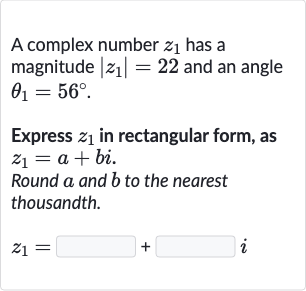Full solution
Q. A complex number has a magnitude and an angle .Express in rectangular form, as .Round and to the nearest thousandth.
- Formulas for conversion: To convert a complex number from polar to rectangular form, we use the formulas and , where is the magnitude and is the angle in degrees.
- Calculating the real part: First, we calculate the real part of the complex number . We have and degrees. So, .
- Finding the value of : Using a calculator, we find that is approximately . Therefore, .
- Calculating the imaginary part: Performing the multiplication, we get . We round this to the nearest thousandth to get .
- Finding the value of : Next, we calculate the imaginary part of the complex number . We have and degrees. So, degrees).
- Finding the value of : Next, we calculate the imaginary part of the complex number . We have and degrees. So, degrees). Using a calculator, we find that degrees) is approximately . Therefore, .
- Finding the value of : Next, we calculate the imaginary part of the complex number . We have and degrees. So, .Using a calculator, we find that is approximately . Therefore, .Performing the multiplication, we get . We round this to the nearest thousandth to get .
More problems from Compare linear and exponential growth
QuestionGet tutor help
QuestionGet tutor help
QuestionGet tutor help
QuestionGet tutor help
QuestionGet tutor help
QuestionGet tutor help
QuestionGet tutor help

